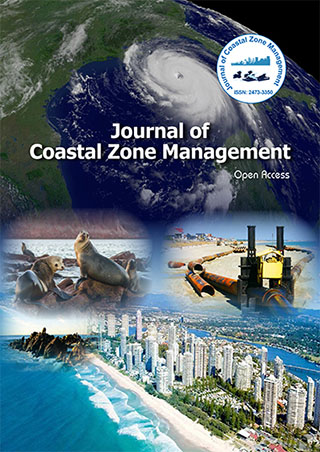Indexed In
- SafetyLit
- RefSeek
- Hamdard University
- EBSCO A-Z
- OCLC- WorldCat
- Publons
Useful Links
Share This Page
Journal Flyer

Open Access Journals
- Agri and Aquaculture
- Biochemistry
- Bioinformatics & Systems Biology
- Business & Management
- Chemistry
- Clinical Sciences
- Engineering
- Food & Nutrition
- General Science
- Genetics & Molecular Biology
- Immunology & Microbiology
- Medical Sciences
- Neuroscience & Psychology
- Nursing & Health Care
- Pharmaceutical Sciences
Opinion Article - (2022) Volume 25, Issue 9
Importance of Estuaries: Environmental Facts and its Benefits
David Chen*Received: 05-Sep-2022, Manuscript No. JCZM-22-18193; Editor assigned: 07-Sep-2022, Pre QC No. JCZM-22-18193 (PQ); Reviewed: 22-Sep-2022, QC No. JCZM-22-18193; Revised: 30-Sep-2022, Manuscript No. JCZM-22-18193 (R); Published: 07-Oct-2022, DOI: 10.35248/2473-3350.22.25.522
Description
A partially contained, coastal body of water called an estuary is where freshwater from rivers and streams and saltwater from the ocean mingling. Estuaries and the regions that surround them serve as transitional areas from the land to the sea. Despite being affected by the tides, they are shielded by land features like barrier islands or peninsulas from the full impact of ocean waves, winds, and storms. When compared to comparable-sized sections of forest, grassland, or agricultural land, estuarine habitats are among the most productive on the planet, producing more organic matter annually. Unique ecosystems of plants and animals uniquely adapted for living at the sea's edge are also supported by the protected waters of estuaries. In and around estuaries, numerous diverse habitat types can be found, such as mudflats, sandy beaches, saltwater and freshwater marshes, swamps, and open shallow waterways.
Essential estuaries
We receive a variety of resources, advantages, and services from estuaries. While some of these can be quantified in terms of dollars and cents, others cannot. Estuaries offer locations for leisure pursuits, academic inquiry, and aesthetic pleasure. Estuaries are a finite natural resource that must be carefully managed for the benefit of all those who rely on them and enjoy them.
Estuaries are important natural environments
Estuarine ecosystems provide homes, food, and breeding grounds for thousands of species of birds, animals, fish, and other creatures. Additionally, estuaries play a crucial role in the growth of many marine organisms, including the majority of fish species that are significant for commerce. Estuaries are excellent locations for migratory birds to rest and refresh since they are biologically productive. Estuaries are frequently referred to as the "nurseries of the sea" since numerous fish and animal species depend on them as safe breeding grounds. Estuaries have significant commercial value, and the resources they contain are profitable for tourism, fishing, and leisure pursuits. Estuaries, which provide harbors and ports that are essential for shipping and transit, support significant public infrastructure. The natural splendor and abundance of estuaries serve as the foundation of the economy in many coastal regions. In 2007, coastal watershed counties produced trillion dollars' worth of Gross Domestic Production (GDP) and supported 69 million jobs.
Estuaries provide benefits to the environment
Estuaries provide numerous more beneficial functions. Sediments, fertilizers, and other contaminants are transported to estuaries by water that drains from uplands. A large portion of the silt and contaminants are filtered out of the water as it passes through wetlands like swamps and salt marshes. Cleaner, clearer water is produced by this filtration process, which is advantageous to both humans and marine life. Other estuary plants and salt marsh grasses also contribute to coastline stabilization and erosion prevention. Additionally, wetlands' vegetation and soils serve as storm surge absorbers and natural barriers between the land and the ocean. By doing this, valuable real estate and upland habitat are shielded from storm and flood damage.
Threats of estuaries
Compared to other counties in the country, coastal counties are growing three times faster. Unfortunately, this growing population density disrupts the estuarine ecosystems' natural balance, threatens their integrity, and puts more strain on important natural resources like estuaries.
The health of the organisms that dwell in an estuary and the water quality are both impacted by what happens on the land. For instance, when a river or stream passes through a farmland, the farming activities' runoff from a storm gathers up fertilizer, manure, and pesticides. It collects materials like fertilizers or pet waste that run off lawns as it flows through urban and suburban regions, untreated sewage from failed septic tanks, wastewater discharges from industrial facilities, silt from building sites, and runoff from impermeable surfaces like parking lots.
Citation: Chen D (2022) Importance of Estuaries: Environmental Facts and its Benefits. J Coast Zone Manag. 25:522.
Copyright: © 2022 Chen D. This is an open-access article distributed under the terms of the Creative Commons Attribution License, which permits unrestricted use, distribution, and reproduction in any medium, provided the original author and source are credited.
